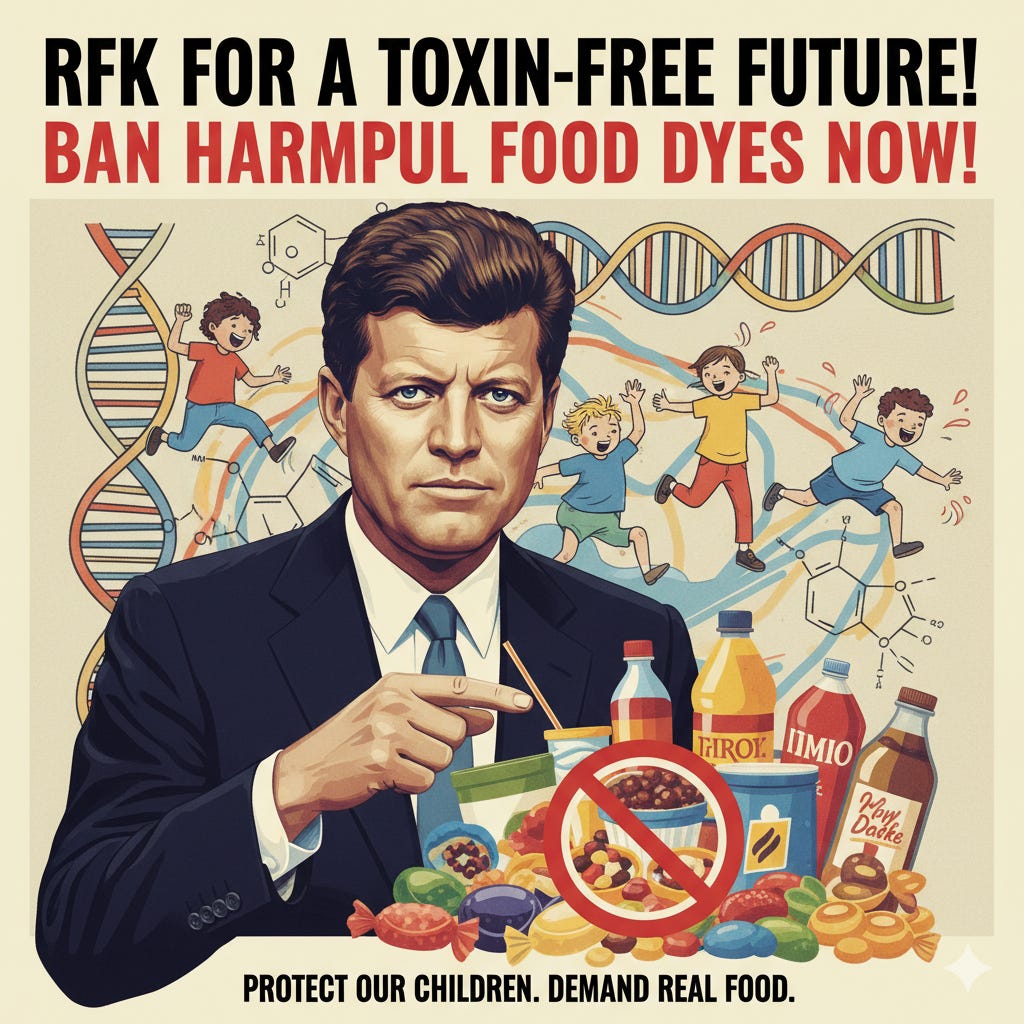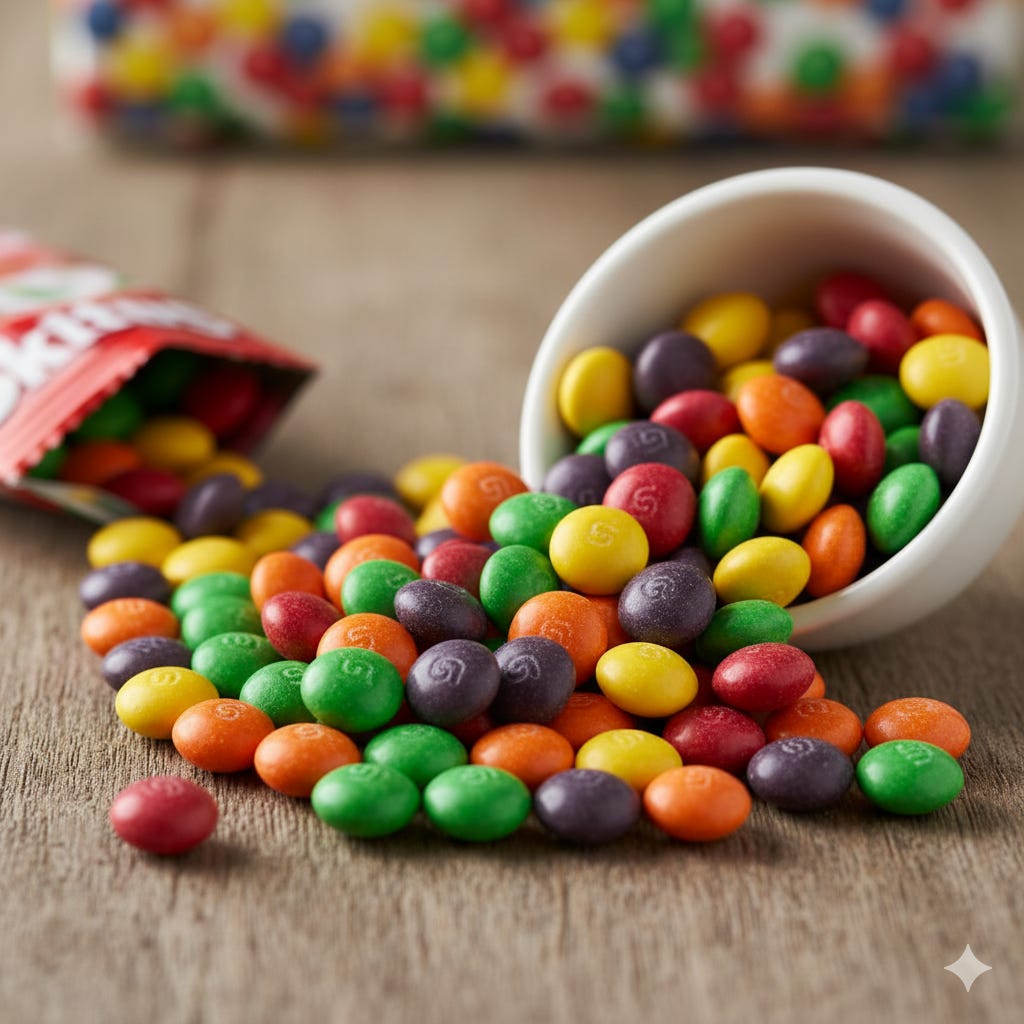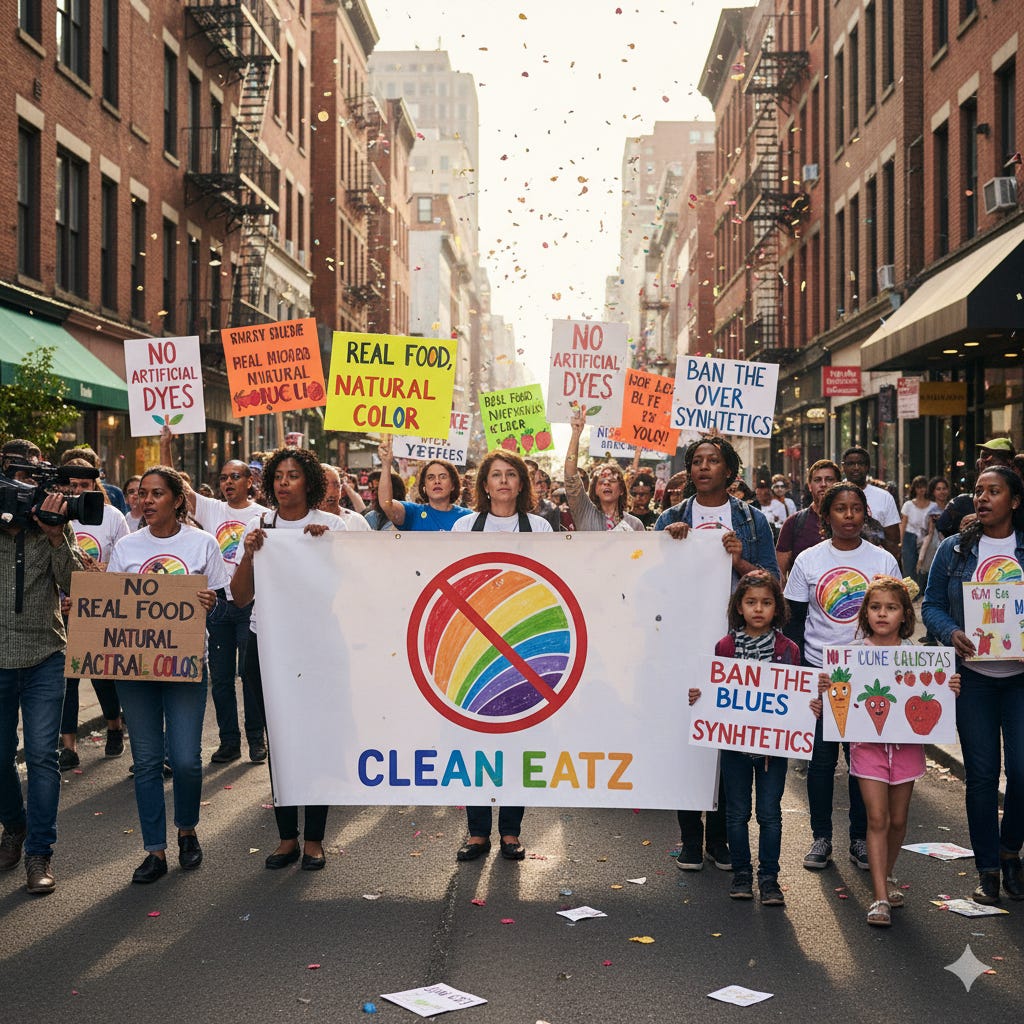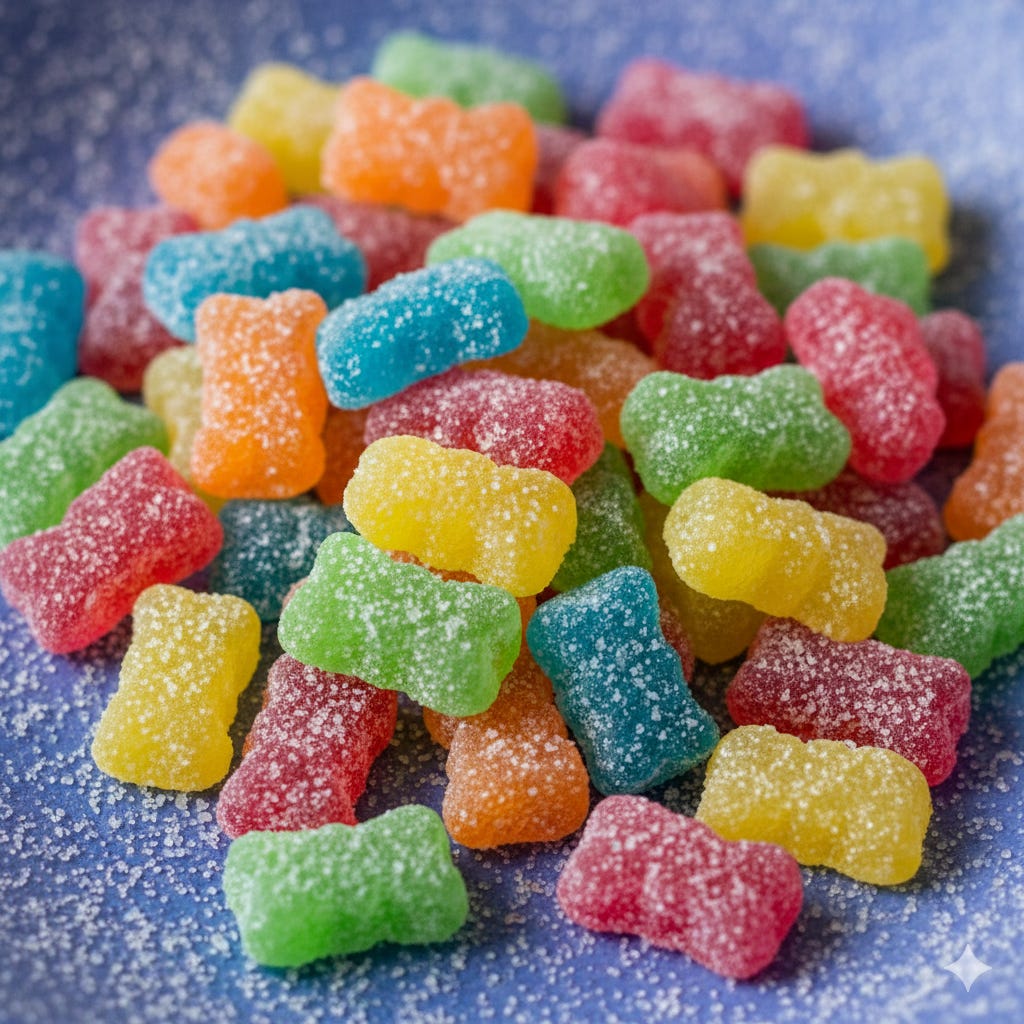The RFK Jr. Policy Purge Playbook: Dye Bans, Drug Tariffs, PBM Shake-Ups | TickerTrends Model Alt Data Platform | Tickertrends.io
The TickerTrends Social Arbitrage Hedge Fund is currently accepting capital. If you are interested in learning more send us an email admin@tickertrends.io
Something strange is bubbling under the surface of the consumer-health market, and most people haven’t stitched the clues together yet. Last month the FDA quietly asked candy and cereal makers to yank the rainbow-bright dyes that have colored U.S. snacks for decades. A week later the White House signed an order that lets new drug-production plants skip years of paperwork if they break ground on American soil. Almost on cue, a draft Senate bill surfaced that would rip the hidden “spread pricing” profits out of big pharmacy benefit managers. Taken alone, each story feels like small-print policy news. Viewed side-by-side, they point to one big idea: Washington is about to rewrite the rulebook on how food, medicine, and pharmacy dollars flow—and money is going to move fast when the first rules lock in.
This report is your early-warning map. In this analysis, we’ve tried to figure out who wins and who loses if the government actually follows through. What I found is surprisingly clear. Within the next 18–24 months:
The six artificial dyes that make gummy bears glow will all but vanish from grocery shelves, forcing manufacturers to buy costlier plant-based colors.
Imports of Chinese drug ingredients could face tariffs big enough to make U.S.-made generics price-competitive again.
The rebate game that props up pharmacy middlemen may get crushed by new federal rules, shrinking a revenue stream Wall Street treats as untouchable.
If even two of those clocks strike on time, a few overlooked mid-cap suppliers and niche retailers could look like growth stocks in a value costume, while a handful of household-name healthcare giants may find their “safe” margins have sprung a leak.
We break down a simple, two-sided trade: a long list of companies already aligned with the new rules—think natural-pigment producers, supplement-heavy grocers, fast-casual chains that brag about clean labels, and generic drug makers that actually manufacture in the States—paired against targeted shorts in businesses the rules directly threaten, like PBM conglomerates and vaccine pure-plays that need an endless booster schedule to justify their multiples. You’ll see real numbers: how one color-ingredient company says every synthetic-to-natural switch multiplies revenue tenfold, why a specialty grocery chain is siphoning customers from mainstream supermarkets, and how a little-known tablet plant in Minnesota could lock in federal contracts before most analysts even tweak their models.
We try to lay out catalysts, timelines, and position sizes. You’ll know the key FDA meeting dates, the tariff phase-in schedule, and the Senate markup that could chop PBM profits overnight—so you can move before the news hits mainstream.
If you’re fine learning about these shifts only after they show up in 13F filings, feel free to stop here. But if you’d rather be the investor those filings report on, tap “subscribe” and grab the full playbook. Policy earthquakes don’t come often; when they do, being early isn’t just better—it’s everything.
Eliminating Harmful Food Additives and Overhauling the American Diet
Brightly colored candies like these often owe their hues to artificial petroleum-based dyes, which RFK Jr. is moving to phase out of the U.S. food supply.
One of Kennedy’s top priorities is a crackdown on artificial additives in foods, aiming to “get rid of every ingredient and additive in food that we can legally address”. Health and Human Services Secretary Robert F. Kennedy Jr. has launched an unprecedented initiative to purge petroleum-based synthetic food dyes from America’s food supply. In a late-April press conference flanked by Food and Drug Administration officials, Kennedy announced that the FDA will work to phase out a suite of artificial color additives widely used in candies, cereals, beverages, and other packaged foods. The plan targets eight synthetic dyes in total – among them Red No. 40, Yellow No. 5, Yellow No. 6, Blue No. 1, Blue No. 2, Green No. 3, and two lesser-used colorings (Citrus Red No. 2 and Orange B) – with the aim of largely eliminating them from foods by the end of 2026.
One dye, Red No. 3 (erythrosine), is already in the process of being banned from foods under a prior FDA decision (it must be removed from food products by 2027 and from medicines by 2028 due to cancer concerns). Under the new initiative, regulators are urging companies to accelerate the removal of Red No. 3 ahead of that schedule while voluntarily fast-tracking the phase-out of the six most common dyes by next year. In parallel, the FDA will formally revoke its approvals for the two rarely used colorings (Citrus Red No. 2, long used to tint orange peels, and Orange B) within “the coming months,” effectively banning them outright. To help fill the gap, the agency plans to authorize at least four new natural color additives in the weeks ahead and expedite review of others, smoothing the path for food manufacturers to switch to non-petroleum alternatives. These measures, Kennedy said, represent a “significant milestone” in the administration’s broader “Make America Healthy Again” campaign, which views the removal of synthetic chemicals from foods as crucial to addressing childhood health issues.
A Voluntary “Phase-Out” vs. a Ban
Notably, Kennedy’s approach stops short of an immediate blanket ban on all artificial dyes – instead, it relies on a phased, cooperative strategy with industry. “We don’t have an agreement; we have an understanding,” he explained, indicating that major food companies have signaled willingness to reformulate products voluntarily rather than by legal mandate. FDA Commissioner Dr. Marty Makary, appearing alongside Kennedy, echoed this collaborative tone. He announced that the FDA had held “wonderful meetings with the food industry” and found manufacturers “eager to do it” – that is, to replace synthetic colors with natural ones on a mutually agreed timeline. As a result, the agency has not yet issued new regulations or binding rules compelling the change. “There’s no need to have a regulation or a statute when companies are volunteering to do it,” Makary said, emphasizing that the FDA will use moral suasion and “every tool in the toolbox” to ensure compliance, short of immediate legal enforcement.
This voluntary phase-out strategy was backed by a behind-the-scenes understanding: a memo and proposal from the Consumer Brands Association (CBA) – a trade group representing major packaged-food companies – had been sent to HHS after a closed-door meeting in March 2025, outlining how manufacturers might proceed with removing dyes on their own initiative. In that proposal, industry members agreed to begin reformulating products within 30 days and to prioritize launching new products without artificial colors. They even committed to providing dye-free versions of foods for school lunch programs as an immediate step. However, the document stopped short of pledging the complete elimination of all artificial dyes by 2026 – a goal Kennedy publicly called for – instead offering support for “agency actions” and partial measures.
From the administration’s perspective, leaning on voluntary compliance offers a faster and less contentious route than formal rule-making. A regulatory ban on approved food additives can be a protracted process, often involving years of scientific reviews, public commentary, and likely court challenges from industry. History shows that outright bans have lagged far behind evidence of harm: Red Dye No. 3, for instance, was barred from use in cosmetics in 1990 after it was shown to cause cancer in lab animals, yet the FDA left it legal in foods for over three decades thereafter. Another additive, brominated vegetable oil, took nearly 50 years of debate before regulators finally moved to prohibit it. Such examples underscore why the FDA under Kennedy and Makary is opting for a cooperative phase-out – they want to achieve quicker results than the cumbersome ban process would likely allow. “Announcing a regulatory change is one step, but then the implementation is another thing,” cautioned Paul Manning, CEO of Sensient Technologies Corp., one of the world’s largest food dye makers. In Manning’s view, getting industry to buy in is critical; he noted that food companies have previously made voluntary promises to remove additives “within a certain timeframe” only to “consistently renege” absent enforceable rules. Kennedy insists this time will be different. He has hinted that if companies drag their feet, “tools to ensure compliance” – potentially including future regulations or legislation – remain on the table as a backstop. But for now, federal health officials are touting cooperation over coercion. An HHS spokesperson told reporters that the companies involved are “eager to engage in discussions” about the phase-out, reinforcing the idea that the commitment is mutual albeit not yet codified in law.
The impetus for removing synthetic dyes is rooted in years of consumer and advocacy pressure over potential health impacts. At the press conference, Secretary Kennedy and Dr. Makary cited a litany of chronic conditions in children – from attention-deficit/hyperactivity disorder (ADHD) to obesity, diabetes, allergies, and even depression – that they believe may be exacerbated by the “toxic soup” of synthetic chemicals in foods. Makary held up scientific studies, including a oft-cited 2007 Lancet study, linking artificial colors to hyperactive behavior in kids. “For the last 50 years, American children have increasingly been living in a toxic soup of synthetic chemicals,” he said, arguing that while eliminating petroleum-based dyes is “not a silver bullet” for child health, it is an important first step. Kennedy struck an even sharper tone, lambasting food makers for “feeding Americans petroleum-based chemicals without their knowledge or consent” and calling these dyes “poisonous compounds” with “no nutritional benefit”. In Kennedy’s view, stripping out synthetic colors is a commonsense move that is long overdue to “safeguard the health of our children” and begin reversing the epidemics of chronic illness. This rhetoric resonates with many parents and health advocates who have campaigned for dye-free foods. The grassroots “Make America Healthy Again” movement – including activist moms who call themselves “MAHA moms” – have been among Kennedy’s loudest supporters. They cheered these announcements, carrying signs like “Make America Healthy Again” at the event, and have been pressuring companies for years to ditch artificial dyes. For example, MAHA-aligned parent groups last year protested outside Kellogg’s headquarters, urging the company to remove synthetic colors from iconic cereals like Froot Loops (which, tellingly, is made with natural dyes in its Canadian version).
Scientists and regulatory experts, however, are split over the necessity and impact of a dye ban. While consumer advocates cite studies in rats and some behavioral research in children, major public health bodies have not concluded that food dyes definitively cause harm to humans. The FDA’s official stance has been that the approved synthetic color additives are safe for the general population in the amounts consumed. “The totality of scientific evidence shows that most children have no adverse effects when consuming foods containing color additives,” the agency noted in a statement earlier this year. Toxicologists point out that no well-controlled human trials have proven a causal link between ingesting food dyes and conditions like ADHD – at most, some susceptible children might be sensitive to large doses. Even the 2007 Lancet study that Makary referenced acknowledged only a possible association with hyperactivity. Emily Acri, a clinical dietitian at Yale, commented that “the information out there is just so minuscule… it’s really hard to make those generalizations” about dyes causing broad health problems. All the same, health authorities in Europe have erred on the side of caution: the European Union requires foods containing certain artificial dyes (including Yellow 5 and Yellow 6) to carry warning labels about potential behavioral effects in children. Largely as a result, most manufacturers selling in Europe long ago switched to natural colorings. The contrast with the U.S. is stark – American shelves are full of vibrantly hued processed foods with petroleum-derived dyes that Europe or the U.K. either bans outright or forces to be disclosed with warning tagsThis transatlantic divide has increasingly become a reputational issue for Big Food companies, especially as U.S. states start to take action of their own.
Patchwork of State Laws Spurs Federal Action
One major factor pushing industry to the negotiating table has been the emergence of state-level bans on artificial food dyes. In the absence of federal restrictions, several states have moved forward with their own laws to limit or label products containing certain additives like Red 40 or Yellow 5. California and West Virginia have led the charge. In West Virginia, a law prohibiting artificial dyes in school cafeterias takes effect in August 2025, making it the first state to implement such a ban in school meals. West Virginia’s statute will escalate further in a few years – by January 1, 2028, it will extend to all foods sold in the state, not just school lunches. California’s legislature, similarly, passed a ban on several additives (including Red 3 and others) for school meal programs, with a broader statewide prohibition also slated for 2028. At least 26 other states – a politically diverse mix from Iowa and Texas to Vermont and Washington – were considering bills in 2024–2025 to restrict synthetic food dyes or require warning labels. This patchwork of regulations was becoming a nightmare for food manufacturers, who would have to juggle different formulations and distribution rules across state lines. The CBA seized on this concern in its discussions with HHS. In the memo it sent after meeting with Kennedy, the trade group explicitly asked the federal government to preempt or discourage the state-by-state approach. It urged President Trump (who took office in January 2025) and Secretary Kennedy to “communicate with governors and state legislatures” that the administration is taking bold national action, and that further state-level mandates would “undermine the President’s leadership” and create costly complexity for companies. “A federal solution is meaningless under a state patchwork regime,” the industry memo argued bluntly. In effect, food companies indicated they would voluntarily make nationwide changes if Washington could assure them a single standard – but they wanted relief from the prospect of 50 different sets of rules. The Consumer Brands Association publicly applauded the FDA and HHS for “reasserting their leadership” on this issue, precisely because a unified federal plan would resolve the burgeoning regulatory patchwork. As CBA President Melissa Hockstad noted, her organization had “long asked HHS and FDA to reestablish themselves as the country’s leading regulatory authority” in food matters. The implication was clear: national rules (even if voluntary at first) are preferable to a balkanized marketplace, and industry was relieved to see federal officials stepping in to set a single timeline and standard for phasing out dyes.
Industry Response
Reactions from food manufacturers and their trade associations have ranged from cooperative to wary. The tone of the April 22nd announcement was one of partnership – no company CEOs stood beside Kennedy, but in the days surrounding the event, several large corporations made statements signaling they’d align with the plan. At the same time, some pushed back on how fast the transition can realistically happen. The International Association of Color Manufacturers (IACM), which represents both natural and artificial color suppliers, issued one of the more critical statements. IACM argued that “requiring reformulation by the end of 2026 ignores scientific evidence and underestimates the complexity of food production”. Reformulating thousands of products is no simple feat, they noted, warning that aggressive timelines could cause supply disruptions and potentially “limit access to familiar, affordable grocery items” if companies can’t adapt in time. This caution reflects the substantial technical challenge here: manufacturers must find suitable natural replacements for each dye in each product, ensure supplies of those natural colorants, and do consumer testing – all within maybe 18–24 months. Even Sensient Technologies’ CEO mused that a full industry shift could realistically take three to four years just to scale up ingredient supply chains. “It’s not as if there are 150 million pounds of beet juice sitting around waiting” for everyone to switch overnight, Manning quipped, illustrating that producing natural dyes (often from agricultural sources like beetroot, turmeric, spirulina algae, etc.) requires time to literally grow and ramp up. “Tens of millions of pounds” of new natural pigments would need to be cultivated and extracted to replace the volume of synthetics currently used. The National Confectioners Association (NCA) – representing candy makers, arguably the heaviest users of synthetic dyes – initially toed a careful line. NCA emphasized that its member companies “follow and will continue to follow regulatory guidance from the authorities in this space, because consumer safety is our chief responsibility”. Pressed by NPR on whether that meant agreeing to eliminate the six petroleum-based dyes, an NCA spokesperson did say “yes”, indicating the candy industry would comply with the phase-out in favor of alternatives. Simultaneously, another NCA statement stressed that science should guide decisions and asserted that global regulators (including the FDA, European Food Safety Authority, etc.) have reviewed these colors and found “no safety concerns”. In a comment to Time, NCA’s spokesperson Christopher Gindlesperger welcomed a “science-based evaluation of food additives” to “eliminate consumer confusion and rebuild trust” – a subtle pushback against what industry sees as chemophobia. This reflects a common industry refrain: our products are safe as is, but we’ll go along with changes to maintain consumer confidence.
The Consumer Brands Association itself publicly conveyed a mix of encouragement and gentle critique. On one hand, CBA praised FDA for leading on a national solution (as noted above). On the other, in its statement it urged officials to “prioritize research that is objective, peer-reviewed and relevant to human health and safety” in evaluating dyes. The subtext was a reminder not to act rashly or emotionally. CBA reiterated that the ingredients in question “have been rigorously studied and demonstrated to be safe” over decades of use. This stance aligns with how major food companies have approached the issue: acknowledging consumer concerns, even reformulating when necessary, but without conceding that they were selling harmful substances. To illustrate, General Mills – maker of cereals like Lucky Charms and Trix, once neon-bright with artificial colors – responded to the FDA announcement by noting that “the vast majority” of its products are already free from synthetic dyes. The company “strongly” supports a single industry-wide standard and is, in its words, “committed to continuing the conversation with the administration”. In other words, General Mills is largely on board and has proactively reduced dyes in its portfolio (indeed, years ago it removed artificial colors from cereals, though some, like Trix, famously reverted to brighter dyes after customer feedback). PepsiCo, which owns not just the namesake soda but also brightly colored snack lines like Cheetos and Doritos, had its CEO Ramon Laguarta publicly indicate support. In fact, earlier in March 2025, Laguarta revealed that most of PepsiCo’s products were already made without artificial colorants and that its remaining uses would be addressed soon. He specifically promised that Lay’s potato chips and Tostitos tortilla chips – two major snack brands that still had some artificially colored flavors – would be fully rid of synthetic dyes by the end of 2025. Furthermore, PepsiCo committed to phasing out artificial colors across its entire portfolio (or at least giving consumers a natural-colored option for all products) over the next few years. This was a significant signal from one of the world’s largest food and beverage companies that it was embracing the change. In the same vein, W.K. Kellogg Co. (the newly formed cereal company after Kellogg’s corporate split) said it had recently met with Secretary Kennedy and has begun reformulating the cereals it sells to school cafeterias so that they will contain no artificial dyes. Kellogg also vowed that starting January 2026, it will not launch any new products with synthetic colors at all. These commitments suggest that, at least for public relations and future planning, big brands are aligning themselves with the dye-free future Kennedy envisions.
Some major players have been quieter – notably Kraft Heinz, which makes everything from neon-orange macaroni and cheese to colorful beverages and candies via its various brands, declined to comment immediately when pressed by news outlets. That said, Kraft Heinz actually has fewer artificial dyes in its lineup than one might think: the company famously removed Yellow No. 5 and 6 from its Kraft Macaroni & Cheese back in 2016, switching to natural spices like paprika and turmeric for color. Many of its Oscar Mayer meats and Heinz sauces are also free of synthetic colors. This trend of “quietly already doing it” applies to others: Mondelez International, for example, had taken steps to eliminate artificial colors from its Nabisco cookie and candy products years prior, and Nestlé (before selling its U.S. candy unit) had removed all artificial dyes from its chocolate candies by 2015. In fact, by 2020 a large swath of U.S. packaged foods had voluntarily gone dye-free in response to consumer demand – one analysis by the Center for Science in the Public Interest found that over 90% of bite-sized fruit-flavored candies, 100% of chewing gums, and the majority of colored breakfast cereals still contained synthetic dyes, but many other categories (yogurts, cheeses, etc.) had largely moved to natural colors. The remaining strongholds of artificial dyes tend to be in children’s products – the brightest candies, cereals, snack chips, ice pops, and drinks aimed at kids and teens, where the marketing value of vibrant color is highest. Those are squarely in the policy’s sights now.
As the shift to natural colorants accelerates, one pressing question is how it will impact costs – for both companies and consumers – and who stands to gain or lose financially. Synthetic dyes rose to dominance in the first place because they are incredibly efficient and cheap: derived from petroleum or coal-tar compounds, artificial colors like Red 40 or Yellow 5 deliver intense coloring power at fractions of a penny per serving. Natural alternatives, by contrast, are much costlier and often need to be used in larger quantities to achieve the same visual effect. For example, achieving a vivid red hue might require a substantial dose of beet or carrot extract or the use of carmine (a pigment derived from cochineal insects), all of which cost more per unit and may impart flavor or stability challenges. Industry analysts estimate that replacing synthetic dyes with natural ones could add as much as 5–10% to manufacturing costs, on average. In some cases the increase might be even higher, especially for products that require a very stable color during heat processing or long shelf life – natural dyes can degrade or change color more readily, requiring special handling or proprietary formulations (which suppliers like Sensient sell at a premium). According to experts, that kind of cost uptick – 10% on the factory level – will almost certainly trickle down to consumers in the form of higher prices at the checkout aisle. One data scientist warned that American households could see their annual food bills rise by thousands of dollars as companies pass on the expenses of reformulation and sourcing pricier ingredients. This figure may be an extreme scenario, but it underscores a real concern: after a period from 2020 to 2024 when grocery prices ballooned nearly 24% cumulatively, further food inflation driven by additive changes is not something consumers will welcome. Trade groups like the NCA have seized on this point, arguing that forcing a rapid switch to natural dyes would make food “significantly more expensive and less accessible” for many families. The CBA’s internal memo similarly fretted about increased production costs and potential loss of consumer appeal for reformulated products. Essentially, the industry message is: we can do this, but it will cost everyone more.






